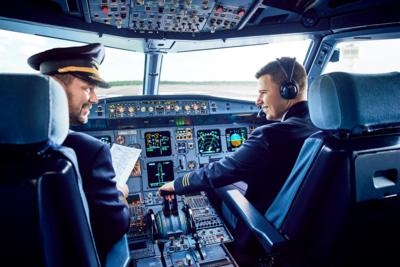Seven Unions And One Trade Association Join Forces To Remove Dangerous Provision From FAA Reauthorization Bill
During the 64th Air Safety Forum, hosted by the Air Line Pilots Association, Int’l (ALPA), the unions representing the pilots of nearly 50 commercial airlines joined together to voice their opposition to a dangerous set of provisions that were added to the FAA reauthorization bill passed earlier this year by the U.S. House of Representatives. Sections 744 and 703(a)(xviii) would authorize a new FAA research and development program in support of single-pilot all-cargo operations utilizing remote-piloting or computer-piloting technology, and ALPA, the Allied Pilots Association (APA), the Coalition of Airline Pilots Associations (CAPA), the Independent Pilots Association (IPA), the International Brotherhood of Teamsters, the NetJets Association of Shared Aircraft Pilots (NJASAP), the Southwest Airlines Pilots Association (SWAPA), want Congress to know how reckless passage of a bill with this provision would be.

Pilots are trained to operate an aircraft while interacting with air traffic control; communicating with Dispatch; checking current weather and forecasts; visually scanning for other aircraft; and monitoring engines, fuel, and other systems. In nonroutine situations, the workload on the flight deck can increase significantly in a short time period. Addressing these situations requires at least two well-trained, fully qualified pilots to communicate in real time without delay or the potential for a lost connection.
“ALPA adamantly opposes FAA Reauthorization Section 744 and will continue to use every resource we have to ensure that this anti-safety provision is not enacted,” said Captain Tim Canoll, ALPA president. “The inclusion of this unacceptable provision serves as an existential threat to aviation safety and security, the general public, and the airline piloting profession.”
“Cargo and passenger carriers operate the same high-performance jet aircraft, share the same congested airspace, and fly over the same densely populated areas. There’s no logical reason to apply different standards to each,” said Capt. Dan Carey, president of APA. “Given the threat posed by computer hacking and the accident rates for autonomous vehicles and military and civilian drones, it’s astonishing that policymakers would even consider this notion. APA is adamantly opposed to the language in Sections 744 and 703(a)(xviii), and we urge Congress to remove it to help preserve public safety.”
“This technology is neither mature, nor proven to a level of confidence capable of assuring a higher level of safety than that which can be attained by two highly qualified, highly trained professional airline pilots on the flight deck,” said Lee Collins, CAPA president. “Having the ability to do so in a lab under controlled circumstances does not mean we should do it in our national airspace system now or at any time in the future.”
“The Teamsters Union strongly opposes FAA Reauthorization Section 744, a dangerous provision that would put aviation safety in jeopardy. Aviation is the safest form of transportation thanks to the regulations and procedures that have been developed over the years, of which the two-person cockpit is a critical component. This provision poses serious risks to the lives of aviation professionals and the public, and we are committed to ensuring that it is not enacted,” said Capt. David Bourne, Teamsters Airline Division director.
“The safety of commercial aviation relies heavily on the experience and coordination of a crew to operate complex aircraft worldwide,” IPA President Robert Travis. “Anything less than two pilots physically in the cockpit will significantly increase risk, especially during emergency operations, when timely actions are coordinated and implemented by each crewmember based on real-time information. Our national aviation system and the general public below the flight paths of aircraft operating within that system cannot afford this unwarranted and unnecessary step backwards in safety.”
“The two-person flight deck model exists not for the sake of redundancy, but to promote safety through shared decision making and communication,” NJASAP President Pedro Leroux said. “Any effort to replace a pilot on the flight deck with unproven automation technology vulnerable to hacking and connectivity issues is an imprudent move that undermines the safety of the flying public, places an excessive burden on professional flight deck crewmembers, and jeopardizes the integrity of the national airspace system.”
“Air travel has never been safer. In fact, 2017 was the safest year in aviation history. Yet, the U.S. Congress is attempting to pass legislation that would allow operators to eliminate one of the most vital safety features of commercial aviation—two pilots in the cockpit. There is no doubt that two well-qualified and well-trained pilots operate as a team in the cockpit and are important contributors to our industry’s ever-improving safety record. We demand that Congress continue to protect the flying public and the crews that operate commercial aircraft by keeping two pilots in the cockpit. No amount of cost savings is worth putting people at risk,” said Capt. Jon Weaks, SWAPA president.
(Source: Joint news release. Image from file)
 ANN's Daily Aero-Term (04.24.24): Runway Lead-in Light System
ANN's Daily Aero-Term (04.24.24): Runway Lead-in Light System ANN's Daily Aero-Linx (04.24.24)
ANN's Daily Aero-Linx (04.24.24) Aero-FAQ: Dave Juwel's Aviation Marketing Stories -- ITBOA BNITBOB
Aero-FAQ: Dave Juwel's Aviation Marketing Stories -- ITBOA BNITBOB Classic Aero-TV: Best Seat in The House -- 'Inside' The AeroShell Aerobatic Team
Classic Aero-TV: Best Seat in The House -- 'Inside' The AeroShell Aerobatic Team Airborne Affordable Flyers 04.18.24: CarbonCub UL, Fisher, Affordable Flyer Expo
Airborne Affordable Flyers 04.18.24: CarbonCub UL, Fisher, Affordable Flyer Expo



